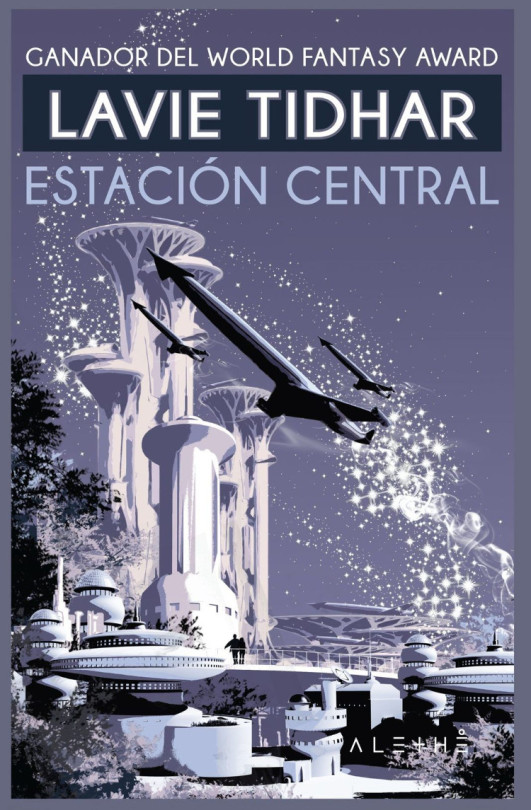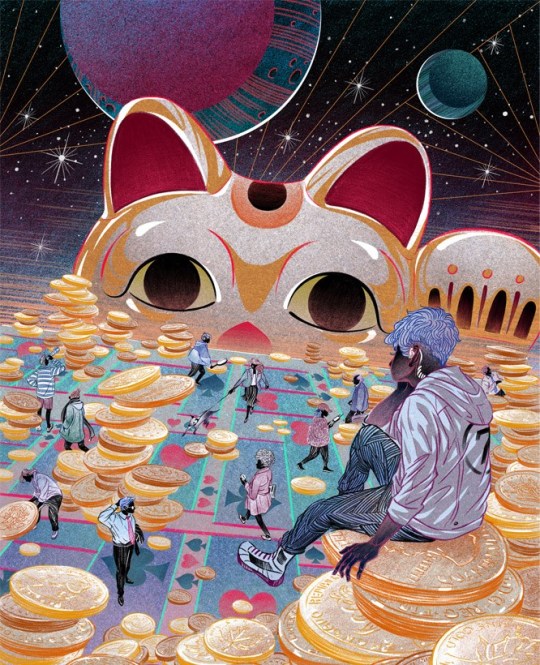Lavie Tidhar’s complex and thoughtful CENTRAL STATION deserves attention

MÁS QUE VENENO praises Lavie Tidhar’s CENTRAL STATION.
The location is transcendental to understand one of the messages that the writer transmits with this story. We are in the future (I estimate that, at least, 150 years from now, maybe 200) in which humanity has expanded through the solar system, created colonies on Mars, the Belt, the moons of Jupiter or Saturn, even I remember some mention of the Oort cloud. There are mentions of a war, but it was 100 years before the fictional present. Tidhar talks about the Jewish city and the Arab city, it is called a demolished wall, but above all it affects the racial diversity that coexists around the Station. As soon as we start the novel we find references not only to Jews and Arabs from the Middle East, but also to people of Filipino, Chinese, Nigerian ancestry and from multiple places on Earth who arrived as refugees there. But the struggles that are so common to us today have been left behind, there are no wars or jokes among the inhabitants. The problems that overwhelm them or can confront them have a quite different origin.

There is a last important issue that has a certain relationship with the multiraciality that it describes. And, just as it shows us characters from different backgrounds, the author also creates new religions , invented, false, digital, derived from the Judeo-Christian tradition, which even complement each other. All coexist and are practiced without any kind of confrontation between them ; In fact, there is a Central Station plant called the multiracial bazaar, or a Reverend of the Robot Church who also circumcised Jewish children and even plans to change their religion at any given time.
I would not say it is a utopian setting, but it is certainly much more optimistic than much of the science fiction that I have read in recent years. It deals with transhumanism without technophobia; development is integrated into people’s lives, we even find symbiotic relationships or genetic manipulation. There is still some ethical reflection on this , but we will not find it explicitly in the text, but let readers be the ones who think about the facts that are reflected in the pages.
<snip>
In short, CENTRAL STATION is a very particular story, complex and very thoughtful, which certainly deserves attention . I even think that for people who are dedicated to writing and creating stories, it is a great sample to analyze and think carefully, because you can extract juice from many parts. For those who simply read, it is a book with an optimal length, a constant rhythm, a prose that flows and invites you to let yourself go. Although terminology and information can be overwhelming at first, immersion is easy and has many messages to ponder . Of course, if you want to read something different, it is a good novel to go to.
(Translation from Spanish courtesy of Google)

Jürgen Doppler for DER STANDARD mentions the novel in Gloomy working worlds in science fiction.
Survival strategies in the precariat of the future produce grim to tragicomic images: Israeli Lavie Tidhar, in his episode novel CENTRAL STATION, begs cyborg soldiers from a forgotten war at the foot of the space elevator to beg for replacement parts. And the author Will McIntosh finds in How the World Ends perhaps the most penetrating picture: On the edge of highways, teenagers with small wind turbines catch the wind that the limousines of the upper class blow to their faces. The electricity they sell to the owners of small shops, the last remaining of the middle class.
(Translation from German courtesy of Google)

Illustration by Feifei Ruan
TOR.COM publishes Lavie Tidhar’s new short story “Yiwu.”
1.
In all his time working for the lottery, Eshamuddin had only ever sold three winning tickets but, as a consequence, he had seen three miraculous things.
The first purchaser, years before, was one of his first ever customers. She was a young, dark-haired girl with a look of intense concentration on her face as she handed over the cash money, and she retained one coin—a Martian shekel with the Golda Meir simulacrum’s head on– to scratch the card, which she did with a slow seesawing motion, gently blowing the cheap dust of silver foil as she searched for her luck.
Then her face changed. Not open disappointment, or stoic acceptance, of the sort that people always wore, nor the greedy desperation that meant they would ask for another ticket, and then another, until their money ran out.
But neither was it amazement, or shock, or any reaction of the sort he’d have expected were someone to get lucky. For someone to win.
It was more like she had found something that she had always half-suspected was there. That she was merely, at last, able to confirm a thing she’d always, instinctively, known.
And then she smiled.
And then she turned into a black-headed ibis and flew away into the sky.

The pre-launch issue of FUTURE SCIENCE
FICTION DIGEST reprints the short story “Earthrise.”
Earthrise:
Imagine the grey chalk surface of the moon spreading before you. You may be watching it from inside one of the cities – perhaps even Lunar Port itself, that oldest and least imaginative of settlements. Most of the cities are underground, deep shafts connecting levels upon levels of housing, shops, factories, drone-zones, waste-disposal oceans, recreational facilities and laboratories. But above all the levels is the Surface, surrounded and protected by a fragile looking dome. Inside the dome are parks and shops and villas. If you live on levels two or three you might journey in the giant elevators, once a week, to reach the surface, and walk in the almost-open air, and shop in the exclusive boutiques and pass the numerous hotels.
But if you were born on the moon you are probably unimpressed by such things, regarding the surface as a place for tourists and poseurs, and seldom go there.
Or assume you are a tourist. Then you stay at Madame Chong’s – if you have the money – right there on Armstrong Boulevard. Or you might stay at the Dojo, or in that row of cheap hotels towards the western side of the bubble, called the Gagarin Lot.
Whichever.
For more info about CENTRAL STATION, visit the Tachyon page.
Cover by Sarah Anne Langton
